Solar eclipse of November 1, 1948
| Solar eclipse of November 1, 1948 | |
|---|---|
| Type of eclipse | |
| Nature | Total |
| Gamma | −0.3517 |
| Magnitude | 1.0231 |
| Maximum eclipse | |
| Duration | 116 s (1 min 56 s) |
| Coordinates | 33°06′S 76°12′E / 33.1°S 76.2°E |
| Max. width of band | 84 km (52 mi) |
| Times (UTC) | |
| Greatest eclipse | 5:59:18 |
| References | |
| Saros | 142 (19 of 72) |
| Catalog # (SE5000) | 9395 |
A total solar eclipse occurred at the Moon's descending node of orbit on Monday, November 1, 1948, with a magnitude of 1.0231. A solar eclipse occurs when the Moon passes between Earth and the Sun, thereby totally or partly obscuring the image of the Sun for a viewer on Earth. A total solar eclipse occurs when the Moon's apparent diameter is larger than the Sun's, blocking all direct sunlight, turning day into darkness. Totality occurs in a narrow path across Earth's surface, with the partial solar eclipse visible over a surrounding region thousands of kilometres wide. Totality was visible from Belgian Congo (today's DR Congo), Uganda Protectorate (today's Uganda) including the capital city Kampala, British Kenya (today's Kenya) including the capital city Nairobi, British Seychelles (today's Seychelles), and British Mauritius (today's Mauritius). During this eclipse, comet C/1948 V1, also known as the Eclipse Comet of 1948, was discovered shining near the Sun.[1]
Related eclipses
[edit]Eclipses in 1948
[edit]- A partial lunar eclipse on April 23, 1948.
- An annular solar eclipse on May 9, 1948.
- A penumbral lunar eclipse on October 18, 1948.
- A total solar eclipse on November 1, 1948.
Metonic
[edit]- Preceded by: Solar eclipse of January 14, 1945
- Followed by: Solar eclipse of August 20, 1952
Tzolkinex
[edit]- Preceded by: Solar eclipse of September 21, 1941
- Followed by: Solar eclipse of December 14, 1955
Half-Saros
[edit]- Preceded by: Lunar eclipse of October 28, 1939
- Followed by: Lunar eclipse of November 7, 1957
Tritos
[edit]- Preceded by: Solar eclipse of December 2, 1937
- Followed by: Solar eclipse of October 2, 1959
Solar Saros 142
[edit]- Preceded by: Solar eclipse of October 21, 1930
- Followed by: Solar eclipse of November 12, 1966
Inex
[edit]- Preceded by: Solar eclipse of November 22, 1919
- Followed by: Solar eclipse of October 12, 1977
Triad
[edit]- Preceded by: Solar eclipse of December 31, 1861
- Followed by: Solar eclipse of September 2, 2035
Solar eclipses of 1946–1949
[edit]This eclipse is a member of a semester series. An eclipse in a semester series of solar eclipses repeats approximately every 177 days and 4 hours (a semester) at alternating nodes of the Moon's orbit.[2]
The partial solar eclipses on January 3, 1946 and June 29, 1946 occur in the previous lunar year eclipse set.
| Solar eclipse series sets from 1946 to 1949 | ||||||
|---|---|---|---|---|---|---|
| Ascending node | Descending node | |||||
| Saros | Map | Gamma | Saros | Map | Gamma | |
| 117 | May 30, 1946 Partial |
−1.0711 | 122 | November 23, 1946 Partial |
1.105 | |
| 127 | May 20, 1947 Total |
−0.3528 | 132 | November 12, 1947 Annular |
0.3743 | |
| 137 | May 9, 1948 Annular |
0.4133 | 142 | November 1, 1948 Total |
−0.3517 | |
| 147 | April 28, 1949 Partial |
1.2068 | 152 | October 21, 1949 Partial |
−1.027 | |
Saros 142
[edit]This eclipse is a part of Saros series 142, repeating every 18 years, 11 days, and containing 72 events. The series started with a partial solar eclipse on April 17, 1624. It contains a hybrid eclipse on July 14, 1768, and total eclipses from July 25, 1786 through October 29, 2543. There are no annular eclipses in this set. The series ends at member 72 as a partial eclipse on June 5, 2904. Its eclipses are tabulated in three columns; every third eclipse in the same column is one exeligmos apart, so they all cast shadows over approximately the same parts of the Earth.
The longest duration of totality will be produced by member 38 at 6 minutes, 34 seconds on May 28, 2291. All eclipses in this series occur at the Moon’s descending node of orbit.[3]
| Series members 11–32 occur between 1801 and 2200: | ||
|---|---|---|
| 11 | 12 | 13 |
 August 5, 1804 |
 August 16, 1822 |
 August 27, 1840 |
| 14 | 15 | 16 |
 September 7, 1858 |
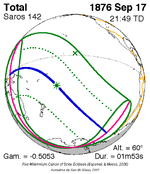 September 17, 1876 |
 September 29, 1894 |
| 17 | 18 | 19 |
 October 10, 1912 |
 October 21, 1930 |
 November 1, 1948 |
| 20 | 21 | 22 |
 November 12, 1966 |
 November 22, 1984 |
 December 4, 2002 |
| 23 | 24 | 25 |
 December 14, 2020 |
 December 26, 2038 |
 January 5, 2057 |
| 26 | 27 | 28 |
 January 16, 2075 |
 January 27, 2093 |
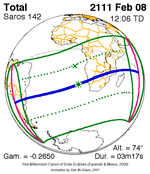 February 8, 2111 |
| 29 | 30 | 31 |
 February 18, 2129 |
 March 2, 2147 |
 March 12, 2165 |
| 32 | ||
 March 23, 2183 | ||
Inex series
[edit]This eclipse is a part of the long period inex cycle, repeating at alternating nodes, every 358 synodic months (≈ 10,571.95 days, or 29 years minus 20 days). Their appearance and longitude are irregular due to a lack of synchronization with the anomalistic month (period of perigee). However, groupings of 3 inex cycles (≈ 87 years minus 2 months) comes close (≈ 1,151.02 anomalistic months), so eclipses are similar in these groupings.
| Inex series members between 1901 and 2100: | ||
|---|---|---|
 November 22, 1919 (Saros 141) |
 November 1, 1948 (Saros 142) |
 October 12, 1977 (Saros 143) |
 September 22, 2006 (Saros 144) |
 September 2, 2035 (Saros 145) |
 August 12, 2064 (Saros 146) |
 July 23, 2093 (Saros 147) |
||
Tritos series
[edit]This eclipse is a part of a tritos cycle, repeating at alternating nodes every 135 synodic months (≈ 3986.63 days, or 11 years minus 1 month). Their appearance and longitude are irregular due to a lack of synchronization with the anomalistic month (period of perigee), but groupings of 3 tritos cycles (≈ 33 years minus 3 months) come close (≈ 434.044 anomalistic months), so eclipses are similar in these groupings.
The partial solar eclipses on December 18, 2188 (part of Saros 164) and November 18, 2199 (part of Saros 165) are also a part of this series but are not included in the table below.
| Series members between 1801 and 2134 | ||||
|---|---|---|---|---|
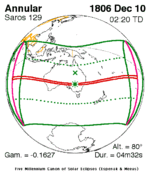 December 10, 1806 (Saros 129) |
 November 9, 1817 (Saros 130) |
 October 9, 1828 (Saros 131) |
 September 7, 1839 (Saros 132) |
 August 7, 1850 (Saros 133) |
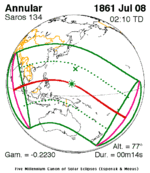 July 8, 1861 (Saros 134) |
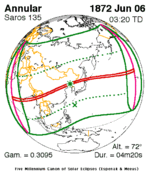 June 6, 1872 (Saros 135) |
 May 6, 1883 (Saros 136) |
 April 6, 1894 (Saros 137) |
 March 6, 1905 (Saros 138) |
 February 3, 1916 (Saros 139) |
 January 3, 1927 (Saros 140) |
 December 2, 1937 (Saros 141) |
 November 1, 1948 (Saros 142) |
 October 2, 1959 (Saros 143) |
 August 31, 1970 (Saros 144) |
 July 31, 1981 (Saros 145) |
 June 30, 1992 (Saros 146) |
 May 31, 2003 (Saros 147) |
 April 29, 2014 (Saros 148) |
 March 29, 2025 (Saros 149) |
 February 27, 2036 (Saros 150) |
 January 26, 2047 (Saros 151) |
 December 26, 2057 (Saros 152) |
 November 24, 2068 (Saros 153) |
 October 24, 2079 (Saros 154) |
 September 23, 2090 (Saros 155) |
 August 24, 2101 (Saros 156) |
 July 23, 2112 (Saros 157) |
 June 23, 2123 (Saros 158) |
 May 23, 2134 (Saros 159) | ||||
Metonic series
[edit]The metonic series repeats eclipses every 19 years (6939.69 days), lasting about 5 cycles. Eclipses occur in nearly the same calendar date. In addition, the octon subseries repeats 1/5 of that or every 3.8 years (1387.94 days). All eclipses in this table occur at the Moon's descending node.
| 22 eclipse events between March 27, 1884 and August 20, 1971 | ||||
|---|---|---|---|---|
| March 27–29 | January 14 | November 1–2 | August 20–21 | June 8 |
| 108 | 110 | 112 | 114 | 116 |
 March 27, 1884 |
 August 20, 1895 |
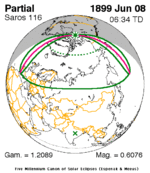 June 8, 1899 | ||
| 118 | 120 | 122 | 124 | 126 |
 March 29, 1903 |
 January 14, 1907 |
 November 2, 1910 |
 August 21, 1914 |
 June 8, 1918 |
| 128 | 130 | 132 | 134 | 136 |
 March 28, 1922 |
 January 14, 1926 |
 November 1, 1929 |
 August 21, 1933 |
 June 8, 1937 |
| 138 | 140 | 142 | 144 | 146 |
 March 27, 1941 |
 January 14, 1945 |
 November 1, 1948 |
 August 20, 1952 |
 June 8, 1956 |
| 148 | 150 | 152 | 154 | |
 March 27, 1960 |
 January 14, 1964 |
 November 2, 1967 |
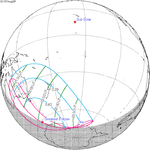 August 20, 1971 | |
Notes
[edit]- ^ Bortle, John E. "The Bright-Comet Chronicles". International Comet Quarterly. Retrieved 20 February 2013.
- ^ van Gent, R.H. "Solar- and Lunar-Eclipse Predictions from Antiquity to the Present". A Catalogue of Eclipse Cycles. Utrecht University. Retrieved 6 October 2018.
- ^ "NASA - Catalog of Solar Eclipses of Saros 142". eclipse.gsfc.nasa.gov.
References
[edit]- Earth visibility chart and eclipse statistics Eclipse Predictions by Fred Espenak, NASA/GSFC




